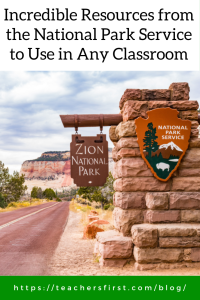You are in for a treat if you haven’t visited the National Park Service website. In addition to providing information for those looking for tips on visiting or enjoying national parks, the site shares an abundance of resources for classrooms and educators to use in many different lessons and activities.
A visit to the website begins with a look at the home page. From the home page, viewers have several options for exploring and finding information.
- Begin by finding a park by state. Use this when researching states, learning about your home state, or comparing features of states.
- For example, which states have the most national parks? Why?
- Use the park service search in reading class to learn about parks in or near a story’s setting. TeachersFirst Reading Treks provide many ideas for books that include locations crucial to the story. Combine Reading Treks activities with visits to national parks to give students a realistic understanding of locations.
- Have students plan and map a visit to a national park. Then, estimate the cost of gas based on miles to drive, overnight stays, food, entertainment, etc.
- Investing in America’s Stories – Learn about funding for National Parks and how our parks preserve and tell stories from around the country. Examples include funding for Native American Graves, Women Who Worked on the Home Front WWII Commemorative Work, and funding to provide equity and access to several parks.
- Ask older students to study the different appropriations for preserving parks and map them using Google My Maps (reviewed here). After mapping the locations receiving funding and evaluating some grants, ask students to share their findings. For example, are there areas missing or receiving an extreme amount of funding? What do the investments tell us about the priorities for the parks?
- New Year, New Goals – This section shares tips for enjoying the health benefits provided through parks. Find challenges and activities throughout the year by selecting your state. Examples of activities for February include walks with archaeologists, tidepool talks, and weekend ranger programs.
- Ask physical education teachers to provide students with challenges based on the New Year, New Goals section tips. Provide incentives for students to earn badges or certificates based on the number of miles walked around your playground or local parks.
- Remembering Dr. King – Visit this page to learn about commemorative activities marking Martin Luther King Day at parks around the country, find and sign up for volunteer opportunities, and virtual visits to the many places and sites related to Dr. King’s life and work.
- Include Remembering Dr. King as part of Martin Luther King Day activities in your classroom or during lessons on civil rights. Find many other ideas for Martin Luther King Day in this resource collection, and at the Remembering Martin Luther King integrated K–4 teaching unit.
- Photos, Videos, Webcams, and More – This is the most robust portion of the site and extremely helpful for many classroom uses. Choose from almost 200,000 resources, including images, webcams, video, audio, and podcasts.
- Visit the webcams to find a large assortment of live images, including Hawaii Volcanoes National Park, several Grand Canyon viewpoints, Mammoth Cave National Park, and many more.
- Check for usage rights when using photos found on the National Parks site. Each image includes copyright and usage information. Find images using keywords in the search bar or narrow results by the image size or national park location.
Scroll down the home page toward the bottom to find additional links that include stories of places and people, protecting the natural world, a section for kids, and America’s Classrooms for Educators.
- The National Park Service educator site is a fantastic resource for teachers of all ages and subjects.
- Take students on a virtual trip to an array of different parks. Some experiences require advance registration to participate in the distance learning event.
- Did you know there are park service materials for loan? For example, borrow a shark traveling trunk, Vital Ice STEM Kit, and Denali Discovery Packs. One hundred and fourteen items are available. Click on any resource to view suggested grade levels, items included, and contact information to borrow the item.
- Another valuable service is the guest speakers available to book through the park service. Visit the link to each description; most speakers are available for booking through the park service location indicated in the description.
- Joshua Tree National Park shares 28 science, history, and community topics on Flip for use in all classrooms. Although it isn’t part of the official National Park Service site, it is a valuable resource to consider using as students learn about geographic features, desert animals, and more. Copy and use any classroom topic or ideas as examples for exploring and discussing other national parks.
Also, remember that the national parks offer several entrance fee-free days annually. Share these dates with students and families to consider when planning travel. This year the free entrance days are:
- January 16 – Martin Luther King Day
- April 22 – First Day of National Park Week
- August 4 – Great American Outdoors Day
- September 23 – National Public Lands Day
- November 11 – Veterans Day
Bookmark and keep the National Parks Service website in mind for many different occasions throughout the school year as a resource to enhance learning across various content areas.
Do you have a favorite National Parks Service resource? Have you incorporated parks into lessons and activities? It’s always great to hear what our readers share in the comments as we learn together.


